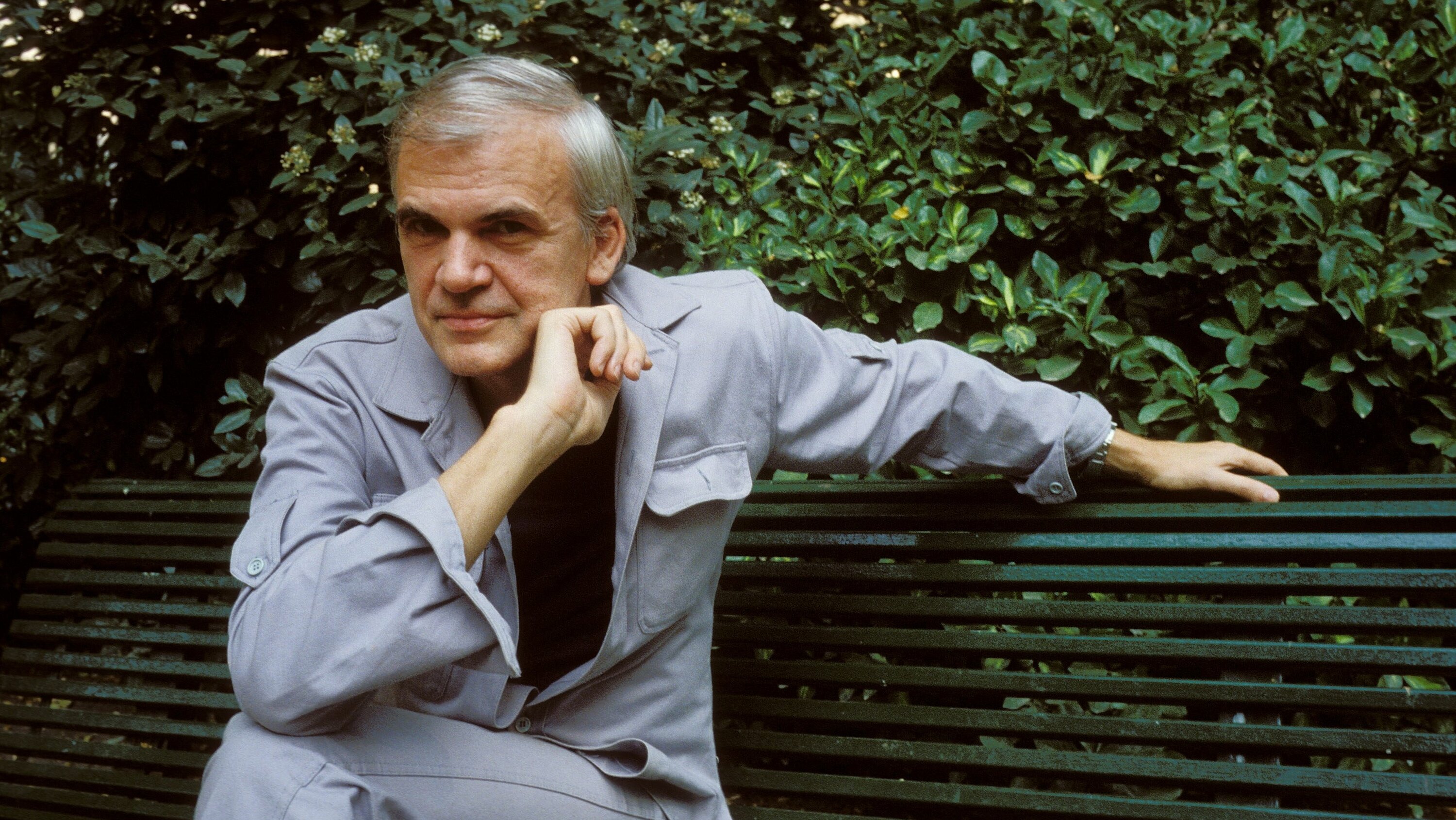Milan Kundera, the Czech writer who died earlier this summer aged 94, represented a number of things, but they were all variations – to borrow one of his own favourite words – on the theme of freedom. To the Western readership which embraced his work perhaps as eagerly as that of any non-Anglophone writer during the final quarter of the twentieth century (Marquez was the obvious competitor) he seemed to offer a distinctive, unorthodox and unassailably authoritative approach to novelistic form, literary history and the sanctity of private life. But no less important to Kundera’s project and legacy were the liberties he took, the freedoms he granted himself – from responsibility and rigour, from his obligations to coherence and even reality.
He was born on April Fools’ Day 1929 in a small Moravian city, Brno, where his father, a pianist, served as the head of the state conservatory named after his mentor Leoš Janáček. Kundera initially studied music before turning to poetry, short stories and plays while lecturing in world literature at the FAMU film school in Prague. Though he had been temporarily expelled in 1950 from the Party, his early collection, Man, A Wide Garden (1954), was a classic of Czech communist verse and Kundera was, in the words of his contemporary Ivan Klíma, ‘an indulged and rewarded child’ of the regime. That changed in 1967, when he published a novel critical of political orthodoxies, The Joke, and delivered a speech at the annual writers’ congress celebrating the vitality of Czech culture and denouncing censorship, a contribution to the reformist movement that culminated in Alexander Dubček’s Prague Spring. After the country’s invasion by Warsaw Pact forces in August 1968, Kundera was fired from his teaching post, and his books – along with those of 400 colleagues – were removed from libraries and banned from shops.
His emergence as a figure of international prominence was extraordinarily swift. Until the late 1960s, Kundera’s only work to attract attention outside Czechoslovakia was a play, The Owner of the Keys (1962). Following publication of The Joke however, he received a visit from a delegation of Latin American writers (Marquez, Cortazar and Fuentes); introducing the French edition, Louis Aragon called it one of the great novels of the century; a film adaptation was shown in London and New York. In 1973, his second novel, Life Is Elsewhere, which had been smuggled out of Czechoslovakia by Claude Gallimard, was awarded the Prix Médicis, an award for under-appreciated writers, and Edgar Faure, the President of the French parliament, helped Kundera and his wife, Věra Hrabánková, to obtain a travel visa. They moved first to Rennes, then Paris, where he was made a professor at the L’École des hautes études en sciences sociales. (He compared his move to a rebirth, something he had previously hoped for from Communism.) Briefly stateless after the revocation of his Czech citizenship, in 1981, he was granted a passport by Mitterrand.
By this point, he was arguably the country’s most famous émigré writer. A one-volume edition of Kundera’s story cycle Laughable Loves had appeared in Philip Roth’s Penguin series ‘Writers from the Other Europe’, and his stirring sequence of related narratives The Book of Laughter and Forgetting (1980), the first book he wrote in exile, was serialized in the New Yorker. When it appeared in hardback, the New York Times ran both an interview with Roth and a review by John Updike under the shared headline ‘The Most Original Book of the Season’. Kundera was felt to be bringing news from behind the Iron Curtain, offering descriptions of Soviet oppression and hypocrisy – the most memorable being a passage about the Communist poet Paul Éluard participating in an anniversary dance while his friend Záviš Kalandra was being hanged. But in a development that Kundera welcomed, his intervention was taken as primarily formal, political to the degree that it challenged the primacy of politics – no ‘dissident’ intervention along the lines of Czesław Milosz’s The Captive Mind (1953) or Aleksandr Solzhenitsyn’s Cancer Ward (1968). Kundera chose to write about the society he had left for the virtues it embodied, however residual or under siege. History in his telling was ‘an alien force’ which man ‘cannot control’, yet the novel was ‘born of man’s freedom’. His kind of ‘thinking novel’ – almost always divided into seven parts – was an assembly of narrated episodes, ‘reflective passages’, macro-structural dichotomies, adaptation of musical techniques (leitmotif, counterpoint, fugue, variation), anecdote, allegory, dream, fairytale and farce. There was consensus over the sort of unencumbered authorial figure he cut. John Bayley described him as ‘a man let loose among all the literary fashions of the West, grabbing this and that, intoxicated by the display patterns of freedom’, while Terry Eagleton, as different a critic as you could imagine (though unlikely successor to Bayley’s Oxford chair), remarked that he ‘treats the novel as a place where you can write anything you like’.
During the closing act of the Cold War, in a literary culture characterized by self-conscious cosmopolitanism and PEN galas, Kundera was the object of rhapsody, his work discussed – or name dropped – by a dizzying range of figures at or near their own height of prominence, from E.L. Doctorow to Tzvetan Todorov, Italo Calvino to Elizabeth Hardwick, David Lodge to Madonna. Raymond Carver, leading short story writer of the day, used the key passage from The Unbearable Lightness of Being – about the ‘lightness’ imposed on human beings by having only one life – as the epigraph for his final collection Elephant (1988). Kundera provoked not just passionate advocacy but acts of devotion. Ian McEwan, a committed anti-Communist and notably reluctant literary journalist, reviewed both The Book of Laughter and Forgetting and Kundera’s next novel, The Unbearable Lightness of Being (1984), in addition to interviewing him for Granta; Edmund White, newly celebrated as the author of A Boy’s Own Story (1982), translated from French his lecture on the tragedy befalling ‘Central Europe’; Susan Sontag turned theatre director to stage his play Jacques and his Master, at Harvard’s American Repertory Theater, in 1985.
Kundera’s aims and sensibility came into sharper focus with the appearance of his literary essays, collected in a series of books starting with The Art of the Novel in 1986. Reviewing Philip Kaufman’s film of The Unbearable Lightness of Being (1988), Pauline Kael explained that Kundera set himself up as a ‘rational spokesman for playfulness’, mischievously adding (in parenthesis) that he ‘also sees it as a tradition’. That tradition originated in the early days of the novel – Rabelais, Cervantes, Sterne, Diderot, de Laclos – and rallied again with Kafka, Musil and Broch. The tendencies of the nineteenth century, the novel’s putative peak, were at once too Romantic or subjectivist, too in thrall to plot at the expense of a confiding narrator. According to another conception of the thinking novel – Bakhtin’s theory of dialogism – Dostoevsky would belong in this company, as a practitioner of Menippean satire. But for Kundera, Dostoevsky was the bête noire, an example of a writer for whom feeling was elevated to the rank of truth – a lyrical attitude that the true novelist existed to expose.
In The Joke, he had offered something close to a paean to mid-life disappointment, the realization that one’s dreams were a lie. Life is Elsewhere (1973), about a poet and police informer who dies aged twenty, more directly revealed the enemy as youth and putatively youthful concepts – solipsism, revolutionary fervour, the poetic impulse. ‘A person becomes mature when he leaves his “lyrical age” behind’. At the end of The Book of Laughter and Forgetting, in a passage Kundera described as an ‘oneiric image of an infantocratic future’, Taomina moves to an island exclusively populated by children and is killed. In the same book, Kundera outlined two kinds of laughter, that of the devil, who exhibits lofty disdain for the idea of order, and that of angels, who laugh to restore or underscore a sense of divine harmonies. His concept of a ‘broadly developed and mature personality’ was one that recognised ‘illusions concerning progress’.
There’s an obvious precedent for an aesthetically inclined, would-be apolitical, anti-Soviet, Dostoevsky-bashing novelist with a wife named Vera, who dispensed churlish mots, set great store by a specialized category of bad taste, published in a second language, railed against sentiment and seriousness, and found fame in exile: Vladimir Nabokov. But Kundera exhibited a deeper kinship with another exile from the East, Joseph Conrad, whose work was underpinned by a similar conviction about the futility of human agency. (Conrad went so far as refusing to sign petitions, even one protesting the imminent execution of his old friend Roger Casement.) Defining irony in a glossary of words collected in The Art of the Novel, Kundera quotes a would-be revolutionary from Conrad’s Under Western Eyes – a riposte to Dostoevsky – to the effect that an ironic stance negates ‘all saving instincts . . . all faith . . . all devotion . . . all action’. The formulation finds an inverted echo in Kundera’s claim, in a well-known passage from The Unbearable Lightness of Being, that ‘kitsch’, a term he associated with self-serving fantasies but applied to virtually anything he did not like, banishes ‘every doubt (because anyone who starts doubting details will end up by doubting life itself)’ and ‘all irony (because in the realm of kitsch everything must be taken quite seriously)’.
The title of The Joke refers to a lampoon of Party optimism sent on a postcard by Ludvik, one of the narrators, to an earnest girlfriend, who reports him. But it also refers to the joke played on him by fate when decades later he tries to exact revenge. His ‘mission’ involves seducing the wife of the apparatchik who ruined his life only to discover that the man is a willing cuckold, glad to be shot of her. In the memorable final section of The Unbearable Lightness of Being, Tomas, a promiscuous former surgeon, and Tereza, the woman who has ended his regime of ‘erotic friendships’, are living deep in the Czech countryside, an internal exile resulting from a half-hearted but nonetheless ill-fated anti-Communist gesture on Tomas’s part. (The setting recalls Patusan, where ‘Lord’ Jim moves to leave behind what Marlow calls his ‘earthly failings’ and ‘reputation’.) In the final moments, Tereza apologises to Tomas. She had forced him to move back to Prague from Geneva on account of her homesickness. He is quick to reject the apology. When she says that surgery had been his mission, he insists that missions are ‘stupid’. He calls it ‘a terrific relief’ to recognize you’re ‘free, free of missions’ – a position no less applicable, it seems, to working as a surgeon than to taking a fruitless and costly stand against a repressive government.
The central difference between Kundera and Conrad is how they conceive of the next step. Their attitude to radical programmes – to programmes of any kind – was similarly pitying and dismissive, but whereas Conrad deployed irony as something like a filter, a tool and marker of his detachment from terrestrial affairs, an aid in his search for transcendent meaning, Kundera was on constant guard against being gulled. To Conrad, a higher salvation was possible – if ‘saving instincts’ were to be rejected, it was in favour of a ‘saving truth’. Kundera receded into a pseudo-rationalist defeatism.
Václav Havel, who had debated Kundera in the late 1960s on the question of whether Czechoslovakia was consigned to its fate, noted with admirable empathy that ‘total scepticism of Kundera’s kind’ was a ‘natural outcome of losing one’s enthusiastic illusions’. Kundera acknowledged that his own ‘lyric age’ had coincided with ‘the worst period of the Stalinist era’, yet this awareness failed to put a brake on his convictions. In his essay ‘Paris or Prague’, which appeared in English in Granta in 1984, he identified himself as an optimist of scepticism, a believer in scepticism’s force and power to prevail. He continued that what he shared with Central European novelists was ‘sorrow about the Western twilight. Not a sentimental sorrow. An ironic one.’ But it’s hard to construe what this distinction amounts to in the sphere of practice, how it differs from the fruitless despair that Sartre, discussing The Joke in his 1971 essay ‘The Socialism that Came in from the Cold’, was adamant that Kundera had stopped short of exhibiting.
Kundera’s positive vision was entirely retrospective. As he wrote of Tereza in The Unbearable Lightness of Being: ‘Only looking back could bring her consolation’. He defined a European as ‘one who is nostalgic for Europe’, and called ‘Czechoslovakia’, which originated in 1918, ‘too young’ a term to use. He was especially drawn to the idea of Central Europe, of which Bohemia formed a part, having been destroyed by Communism, an Eastern import – ‘raped by Asia’, in Havel’s paraphrase. He invoked a lost haven of pluralism and variety, a unity that ignored conventional topographic borders and markers, and was prone to saying things like ‘Do you know that in the seventeenth century Lithuania was a powerful European nation?’ It was exactly the sort of misty thinking that he professed to deride. Perry Anderson compared the notion that Kundera’s homeland was closer to ‘Western than Eastern patterns of historical experience’ to ‘the kind of redescription to be found in estate agents’ brochures’. Even Timothy Garton Ash, a fellow promoter of a Central European mirage, recognized that Kundera’s treatment of Russia was ‘absurd’.
The sternest rebuke came from Joseph Brodsky, writing in 1985, in response to an essay in which Kundera cleanly equated Communism, Dostoevky’s novels, and Eastern irrationality. Brodsky was no supporter of the Soviet Union – he moved to America after enduring a decade of persecution – but he lamented Kundera’s ‘lopsided’ historical vision. And though he said that he could readily understand why Kundera should wish to be more European than the Europeans, he argued that Kundera displayed a stubborn aversion to remembering the intellectual origins of Nazism and Marxism, and the emotional radicalism that was supposed to underpin them. ‘The idea of the noble savage, of an inherently good human nature hampered by bad institutions, of the ideal state, of social justice and so forth – none of these originated or blossomed on the banks of the Volga’, he wrote. On seeing a Russian tank in the street, there was ‘every reason to think of Diderot’ – the writer Kundera had turned to when asked to adapt The Idiot for the stage. (‘I do not feel qualified to debate those who blame Voltaire for the gulag’, Kundera said a few months later, when receiving the Jerusalem Prize.) Dostoevsky’s novels in fact portrayed the Russian denouements to scenarios that developed in the West. The Possessed, for example, provided a reminder that Communism had encountered greater resistance in Russia than it later would in Kundera’s beloved and super-sensible Central Europe.
Brodsky, though focused on a local debate, had identified Kundera’s characteristic capacity for swatting aside any obstacle to what he wanted to say or do. He was not alone. Milan Jungmann claimed that in Kundera’s interviews his ‘true likeness is completely obliterated’. Like Tomas’s lover Sabina in The Unbearable Lightness of Being, he began to insert ‘mystifications’ into his biography, describing himself in the period before the invasion as a ‘relatively unknown Czech intellectual’. The scholar J.P. Stern accused him of perpetuating ‘the myths on which he and I were brought up’. Todorov noted that Kundera’s belief that barbarity reigns was hardly compatible with the wide recognition of his work; Will Self that his reductive certitude was ‘poorly governed’ by its avowed belief in a pluralist mindset. Kundera’s fiction was by no means immune. Updike felt that elements of The Book of Laughter and Forgetting were ‘rooted in the sky, in whims beyond accounting’, and later summarized its effect as ‘etherealized’. Klíma, notionally ventriloquizing the position of the Czech intelligentsia – though with notable gusto – said that ‘the hardness of life has a much more complicated shape’ than we find in Kundera’s novels, which instead resembled ‘the sort of picture you would see from a very capable foreign journalist who’d spent a few days in our country’.
Yet this cluster of vices – a vice-in-variations – is largely absent from The Unbearable Lightness of Being. A star-crossed love story, it is, along with The Joke, his most solidly constructed book, far less capricious and conversational than its predecessor The Book of Laughter and Forgetting or successor Immortality (1988) or the four novellas he wrote in French, Slowness (1995), Identity (1998), Ignorance (2000) and The Festival of Insignificance (2014). It also offers the widest range of competing visions, and more than anything he wrote resists – though it did of course attract – the go-to Kundera adjective, ‘brilliant’. Janet Malcolm noted that the novel seemed to lead a ‘charmed life . . . Every door Kundera tries opens for him’. The claim is reminiscent of Updike calling The Great Gatsby ‘superbly fortunate’ and of James Wood’s reflection that certain novels – he named Dead Souls, Midnight’s Children, and Herzog – achieve something like ‘the inventor’s secret machine, elixir, or formula’.
In a sense, The Joke, with its devilish central conceit, more properly belongs in this company. But The Unbearable Lightness of Being offers portraits of characters who achieve dynamic life while illustrating the narrator’s stated theme – whether or not to live with ties, and the impossibility, within a single life, of evaluating the chosen course. The most palpable source of luck is that the seductive quiddity of narrative works not only to rein in Kundera’s discursive tics but also outwit his habitual certainties. The ‘lightness’ of a life without commitment is revealed as freighted with risk, as fraught with danger, as an existence weighed down by connection or conviction. The emphasis on the difficulty of having just one life, of not having the benefit of ‘eternal recurrence,’ forces a recognition in Kundera of the precarious truth-status of any position: engagement or apathy, feeling or detachment, Geneva or Prague. But, however at odds this was with how he talked about the world, it vindicates his idea of the novel – as a vehicle for uncertainty, a route to ‘suprapersonal wisdom’, much as Franz, an academic and devoted dissident with whom Tomas shares a lover, says that New York achieves a richness that far exceeds the conscious intentions of ‘human design’. Kundera frequently cut corners – Todorov used the word ‘oversimplification’, Klíma ‘simplified’ – but he also managed to write at least one book that tells the reader, as he said a novel should, that ‘things are not as simple as they seem’.
In 2002, Harold Bloom, in a nominal introduction to a collection of essays exploring Kundera’s work, cast doubt over the writer’s ‘lasting eminence’. He called The Unbearable Lightness of Being ‘formulaic, over-determined, and in places unbearably light’, and asserted – on what basis he does not specify – that ‘young people no longer go off to the Czech capital with his novels in their backpacks’. Kundera may have ceased to be a cult or sensation, the near-to-hand reference-point that he had been for the Gen X heroes of Nick Hornby’s High Fidelity (1995) and Noah Baumbach’s Kicking and Screaming (1995).
Such gloating talk of Kundera’s eclipse is exaggerated. If he was no longer in backpacks, he was still on library desks and bedside tables. And his example has endured. Geoff Dyer, noting that readers had started to take their ‘amazement’ with Kundera for granted, argued that, far from being a mere ‘influence’ like, say, Martin Amis – stylistic, or tonal, or temperamental – he had developed a novelistic software that fellow practitioners could download. Writers who have directly cited his influence include Adam Thirlwell, Jonathan Safran Foer, Benjamin Markovits, Leïla Slimani, Taiye Selasi. Though The Unbearable Lightness of Being has claims to being a separate, extra-authorial phenomenon – it is at once his best-known and least typical book – the vision of the thinking novel as exemplified in The Book of Laughter and Forgetting and Immortality anticipated the essayism and autofiction now rather narrowly credited to W.G. Sebald.
A greater challenge to Kundera’s legacy than the inevitable loss of modishness may be the charge most extensively levelled by Joan Smith in the ‘Czech mates’ chapter of her book Misogynies (1989). Even Jonathan Coe, having defended him against Smith’s claims, ended his 2015 essay ‘How Important Is Milan Kundera Today?’ with a reference to ‘the problematic sexual politics which send ripples of disquiet through even his finest books’. But this seems not to be the dominant position today. Gina Frangello, writing in the LARB in 2020, acknowledged Kundera’s misogyny only in the course of celebrating his work as a ‘definitive craft book’ on the uses of authorial omniscience. As recently as May – 37 years after the Madonna name-check – the English-Albanian pop star Dua Lipa praised The Unbearable Lightness of Being for its portrayal of sexual relationships.
It is easy to imagine Kundera’s novel enjoying an essentially charmed afterlife as well, proving sufficiently resilient or multivalent to withstand polemical blows, becoming a beneficiary as well a victim of the loss of its original context in Cold War jockeying and Anglo-American fetishism of Slavic sexual freedoms. John Banville expressed his astonishment, on returning to the book in the new millennium, at how little ‘a work so firmly rooted in its time’ had seemed to age. But then distance is often a boon to the longer-term reputation of writers apparently defined by a series of spot-lit moments, offering readers a reprieve from churlish sermonizing, misplaced stridency, or the spectacle of artistic decline, and bringing a sense of proportion and perspective, even a kind of serenity, a freedom from the fray, that provides more fertile ground for appreciation. As Tomas reflects, following a break-up with Tereza, ‘Now what was tiring had disappeared and only the beauty remained’.
Read on: Jiří Hájek, ‘Condition of the Novel (Czechoslovakia)’, NLR I/29.









